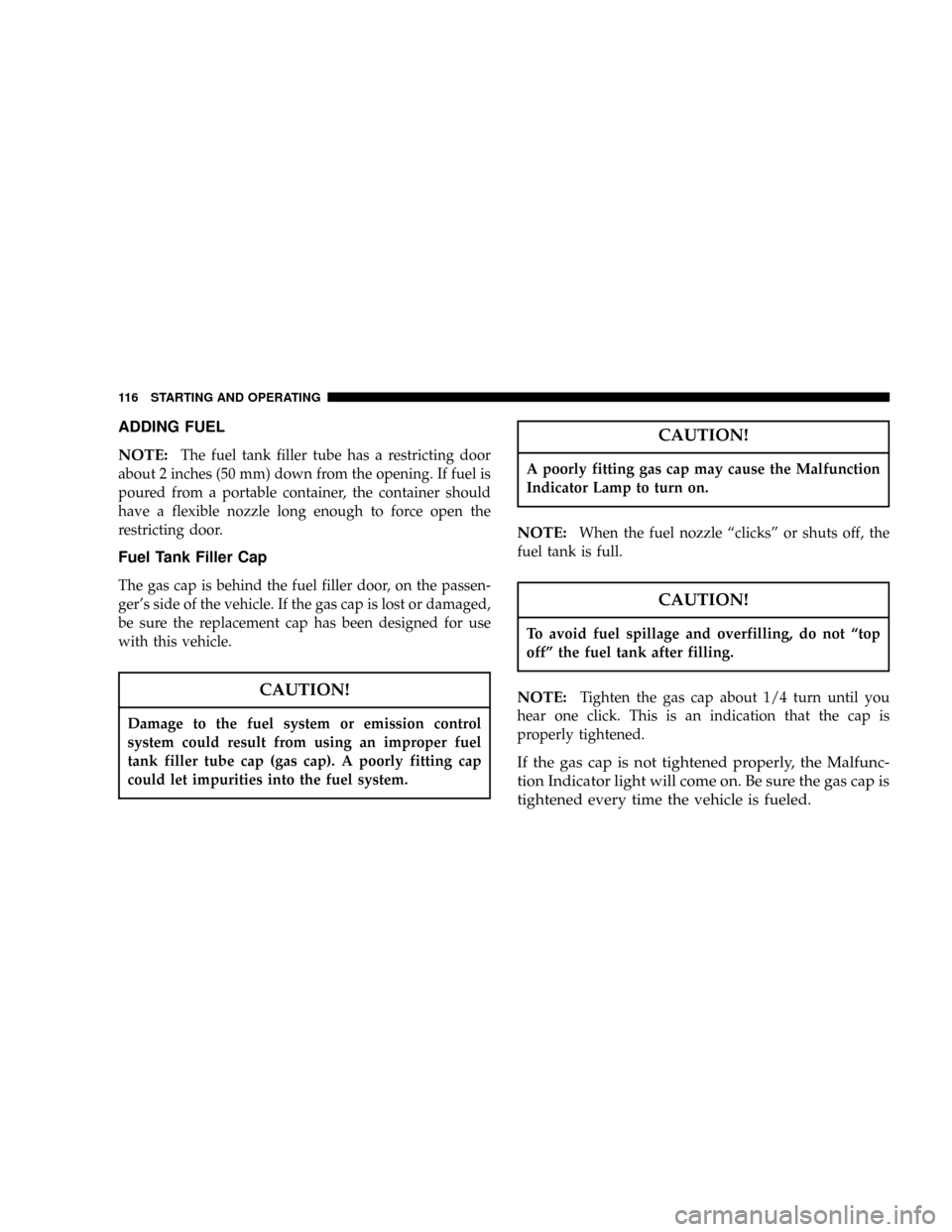Page 96 of 200

TIRE SAFETY INFORMATION
Tire Markings
NOTE:
²
P(Passenger)-Metric tire sizing is based on U.S. design
standards. P-Metric tires have the letter ªPº molded
into the sidewall preceding the size designation. Ex-
ample: P215/65R15 95H.
²European Metric tire sizing is based on European
design standards. Tires designed to this standard have
the tire size molded into the sidewall beginning with
the section width. The letter9P9is absent from this tire
size designation. Example: 215/65R15 96H
²LT(Light Truck)-Metric tire sizing is based on U.S.
design standards. The size designation for LT-Metric
tires is the same as for P-Metric tires except for the
letters ªLTº that are molded into the sidewall preced-
ing the size designation. Example: LT235/85R16.
²Temporary Spare tires are high pressure compact
spares designed for temporary emergency use only.
Tires designed to this standard have the letter ªTº
molded into the sidewall preceding the size designa-
tion. Example: T145/80D18 103M.
²High Flotation tire sizing is based on U.S. design
standards and begins with the tire diameter molded
into the sidewall. Example: 31x10.5 R15 LT.
96 STARTING AND OPERATING
Page 97 of 200
Tire Sizing Chart
EXAMPLE:
Size Designation:
P = Passenger car tire size based on U.S. design standards
(....blank....(= Passenger car tire based on European design standards
LT = Light Truck tire based on U.S. design standards
T = Temporary Spare tire
31 = Overall Diameter in Inches (in)
215 = Section Width in Milimeters (mm)
65 = Aspect Ratio in Percent (%)
ÐRatio of section height to section width of tire.
10.5 = Section Width in Inches (in)
R = Construction Code
Ð9R9means Radial Construction.
Ð9D9means Diagonal or Bias Construction.
15 = Rim Diameter in Inches (in)
STARTING AND OPERATING 97
5
Page 98 of 200
EXAMPLE:
Service Description:
95 = Load Index
ÐA numerical code associated with the maximum load a tire can carry.
H = Speed Symbol
ÐA symbol indicating the range of speeds at which a tire can carry a load corresponding
to its load index under certain operating conditions.
ÐThe maximum speed corresponding to the Speed Symbol should only be achieved un-
der specified operating conditions. (ie. tire pressure, vehicle loading, road conditions and
posted speed limits).
Load Identification:
(....blank....(= Absence of any text on sidewall of the tire indicates a Standard Load (SL) Tire
Extra Load (XL) = Extra Load (or Reinforced) Tire
Light Load = Light Load Tire
C,D,E = Load range associated with the maximum load a tire can carry at a specified pressure
Maximum Load Ð Maximum Load indicates the maximum load this tire is designed to carry.
Maximum Pressure Ð Maximum Pressure indicates the maximum permissible cold tire inflation pressure for
this tire.
98 STARTING AND OPERATING
Page 113 of 200

The required rotation method for directional tires is to
swap the front tire with the rear on the same side of the
vehicle. Do not cross switch tires without dismounting
the tires and re-mounting them in the correct rotational
direction.
SELECTING FUEL
2.4L TURBO
Your engine is designed to meet all emis-
sion regulations and provide excellent fuel
economy and performance when using
high quality unleaded gasoline having an
octane rating of 91. The purchase of higher
octane is not recommended.
High quality unleaded gasoline having a minumum
octane rating of 87 may safely be used for your vehicle.
Use of these lower octane gasolines, however, may result
in reduced acceleration performance.
If low octane fuel (below the recommended 91 octane
(R+M)/2)) is used, boost will be reduced significantly.Normal boost levels will return once the recommended
fuel is used and the engine controller adapts to the fuel
octane level.
Spark Knock
Light spark knock at low engine speeds is not harmful to
your engine. However, continued heavy spark knock at
high speeds can cause damage and immediate service is
required. Engine damage resulting from operation with a
heavy spark knock may not be covered by the new
vehicle warranty.
Poor quality gasoline can cause problems such as hard
starting, stalling and hesitations. If you experience these
symptoms, try another brand of ªregularº gasoline be-
fore considering service for the vehicle.
Over 40 automobile manufacturers around the world
have issued and endorsed consistent gasoline specifica-
tions (the World Wide Fuel Charter, WWFC) to define
fuel properties necessary to deliver enhanced emissions,
engine performance, and durability for your vehicle. The
manufacturer recommends the use of gasolines that meet
the WWFC specifications if they are available.
STARTING AND OPERATING 113
5
Page 115 of 200

vehicle. The MMT content of gasoline may not be indi-
cated on the gasoline pump, therefore you should ask
your gasoline retailer whether or not his/her gasoline
contains MMT.
It is even more important to look for gasolines without
MMT in Canada because MMT can be used at higher
levels than allowed in the United States.
MMT is prohibited in both Federal and California refor-
mulated gasolines.
Sulfur in Gasoline
Your vehicle may have been designed to meet California
low emission standards with cleaner burning California
reformulated gasoline with low sulfur. This vehicle may
be sold nationwide. Your vehicle will operate satisfacto-
rily on fuels meeting Federal specifications, but emission
control system performance may be adversely affected.
Gasoline sold outside of California is permitted to have
higher sulfur levels which may affect the performance of
the vehicle's catalytic converter. This may cause the
Check Engine or Service Engine Soon light to illuminate.
The manufacturer recommends that you try a differentbrand of unleaded gasoline having lower sulfur to deter-
mine if the problem is fuel related prior to returning your
vehicle to an authorized dealer for service.
CAUTION!
If the Check Engine or Service Engine Soon light is
flashing, immediate service is required. See the On
Board Diagnostics paragraph in the Maintenance
section of this manual.
Materials Added to Fuel
All gasoline sold in the United States is required to
contain effective detergent additives. Use of additional
detergents or other additives is not needed under normal
conditions and would result in unnecessary cost. There-
fore you should not have to add anything to the fuel.
STARTING AND OPERATING 115
5
Page 116 of 200

ADDING FUEL
NOTE:
The fuel tank filler tube has a restricting door
about 2 inches (50 mm) down from the opening. If fuel is
poured from a portable container, the container should
have a flexible nozzle long enough to force open the
restricting door.
Fuel Tank Filler Cap
The gas cap is behind the fuel filler door, on the passen-
ger's side of the vehicle. If the gas cap is lost or damaged,
be sure the replacement cap has been designed for use
with this vehicle.
CAUTION!
Damage to the fuel system or emission control
system could result from using an improper fuel
tank filler tube cap (gas cap). A poorly fitting cap
could let impurities into the fuel system.
CAUTION!
A poorly fitting gas cap may cause the Malfunction
Indicator Lamp to turn on.
NOTE:When the fuel nozzle ªclicksº or shuts off, the
fuel tank is full.
CAUTION!
To avoid fuel spillage and overfilling, do not ªtop
offº the fuel tank after filling.
NOTE:Tighten the gas cap about 1/4 turn until you
hear one click. This is an indication that the cap is
properly tightened.
If the gas cap is not tightened properly, the Malfunc-
tion Indicator light will come on. Be sure the gas cap is
tightened every time the vehicle is fueled.
116 STARTING AND OPERATING
Page 124 of 200
Do not raise the vehicle until you are sure the jack is
securely engaged.
4. Raise the vehicle by turning the jack screw to the right.
Raise the vehicle only until the tire clears the surface.
Miminum tire lift provides maximum vehicle stability.WARNING!
Raising the vehicle higher than necessary can make
the vehicle less stable. It could slip off the jack and
hurt someone near it. Raise the vehicle only enough
to remove the tire.
5. Remove the wheel nuts and pull the wheel and wheel
covers where applicable off the hub. Install the spare
wheel and wheel nuts with the cone shaped end of the
nuts toward the wheel. Lightly tighten the nuts. To avoid
the risk of forcing the vehicle off the jack, do not tighten
the nuts fully until the vehicle has been lowered.
WARNING!
To avoid possible personal injury, handle the wheel
covers with care to avoid contact with any sharp
edges.
6. Lower the vehicle by turning the jack screw to the left.
124 WHAT TO DO IN EMERGENCIES
Page 132 of 200
NHoses And Vacuum/Vapor Harnesses.......152
NBrake System........................153
NManual Transaxle.....................155
NAppearance Care And Protection From
Corrosion...........................155
mFuses...............................160
NUnderhood Fuses
(Power Distribution Center)..............160
NInterior Fuses........................161
mVehicle Storage........................161
mReplacement Bulbs.....................162
mBulb Replacement......................163NHeadlight Bulb Replacement.............163
NFront Park/Turn Signal Lights............164
NFront Sidemarker Light.................164
NTail/Stop, Rear Turn Signals And Back-Up
Lights.............................164
NCenter High Mounted Stop Light..........164
mFluid Capacities.......................165
mRecommended Fluids, Lubricants And
Genuine Parts
.........................166
NEngine.............................166
NChassis............................166
132 MAINTAINING YOUR VEHICLE